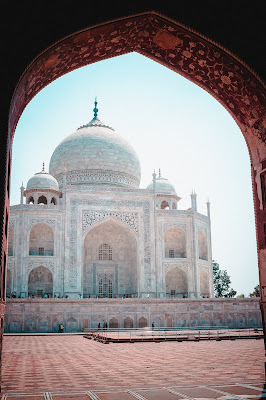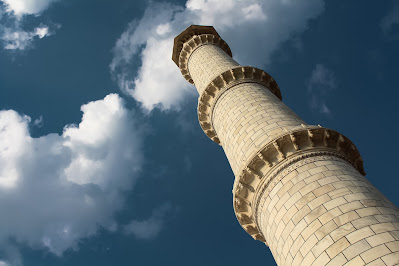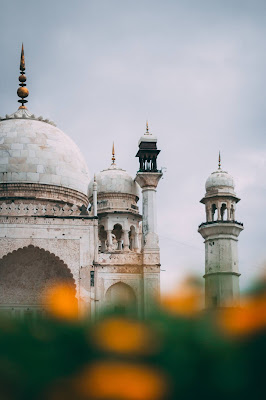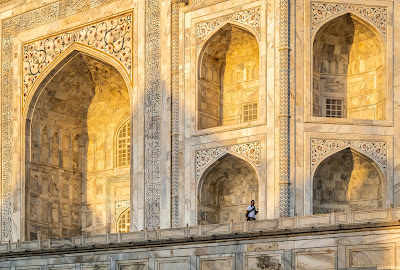Historical Background :
- Taj Mahal is a mausoleum complex built by Shah Jahan (1632-1643) in memory of his favorite wife, Arjumand Banu Begum better known by her title ''Mumtaz Mahal''.
- Construction of the building began shortly after Mumtaz's death.
- Today Taj Mahal is recognized as the most perfect building in the world.
 |
Taj Mahal |
Background :
- According to Islamic traditions, a woman that dies during children's birth gains the status of martyr.
- In 1631 Mumtaz passed away during the birth of her 14th child.
- According to legend, with her dying breath, she secures a promise from her husband to built for her, a mausoleum more beautiful than any the world had ever seen.
- 6 months after the death of his wife, Shah Jahan lays the foundation for a memorial near the river Jamna near his Palace in Agra.
- To satisfy his Artistic obsessions, vast quantities of white marble are mined from Rajhastahn and are carried 250 miles to the site of the Taj Mahal.
- The emperor reserves white marble for imperial building only.
- Red stone carted from Dehli.
- 20,000worker who labored over 20 years to build the monument.
Architectural Breakthrough :
- In Indian architecture, the trabeation system was widely used for the construction of temples.
- The Mughal introduce the concept of the arch to India and create very wide interior spaces.
- Although the essential style was Islamic, any of the details are Hindu/Indian.
- The Mughal introduced the use of ceramic tiles and precious stones for inlay work.
Engineering Breakthrough :
- The Taj Mahal was built next to the river Jumna.
- The Mughal Enginner's dug deep wells to below the water surface.
- These wells were filled up with vocals and mortar.
- On top of Well bases, the master builders erected stone columns, linked together by massive arches.
- This engineering innovation has been protecting the Taj Mahal from the currents of the Jumna river to date.
Minarets Optical illusion :
- The minarets of the Taj Mahal built to lean slightly outwards.
- Depending on each other, they look perfectly straight.
- This brings a massive advantage.
Dome :
- Today we can build a dome-like Taj Mahal using steel frames and other materials.
- The master builders of the Taj Mahal had to solve this problem in stone.
- They Laid stone on stone and built up the stone in rings.
- The dome rises layer by layer.
- The mortar between the stones gives its stability.
Design Components :
Minarets :
The tomb of Shah Jaha's own father provides the model for minarets.
 |
Minarets |
Corner Turrets:
Shah Jahan great grandfather. Akbar tomb had four corner turrets surrounding the central core.
Pishtaq :
The four Pishtaq is inspired by his grandfather Tomb.
Dome :
The dome is inspired by Ulugh Beg Madrasa in Samarkand.
 |
Inside Dome |
Religious Symbolism :
Taj Mahal is the architectural embodiment of this life and the next according to Islamic belief.
The ground plan represents this duality of life and the afterlife.
The complex is split between its tomb garden and mausoleum.
Colour Scheme :
The color scheme of the Taj Mahal is deeply symbolic.
The worldly elements and other buildings are all clad in red stone.
The pure white stands for the Spiritually and faith of the person buried here.
The Garden :
The Garden is the heart of the Taj Mahal.
It is an earthly representation of paradise described in the Quran.
The garden is divided into four squares.
 |
Chahar Bagh |
The channels along the paths represent the river of paradise milk, honey, wine, and water mentioned in the Quran.
Where the channels meet, there is a pool.
European Influence:
The Taj Mahal itself demonstrates the link between India and Europe.
Technique and Motifs traveled from Europe to adorn the entire interior of the Taj Mahal.
These mosaics of semi-precious stones are called Pietra dura.
 |
Pietra Dura |
This craft was used to decorate precious places during the renaissance.
This technique directly or indirectly traveled from Italy to India.
Unfortunately, no chronicles record the name of the artist who decorated the Taj Mahal.
Burial Chamber :
The coffin seen in the Mausoleum is only a cenotaph an empty monument.
Mumtaz Mahal lies in a secret marble chamber below the Taj Mahal, where she rests undistributed.
Here is the view of the Taj Mahal :









very informative.
ReplyDeleteNice
ReplyDeleteSo informative
ReplyDeletegood info..keep it up 👍
ReplyDeleteGreat details about Taj Mahal
ReplyDeleteEasy Tutorials
Informative blog...Good job
ReplyDeleteVery informative ♥️
ReplyDelete